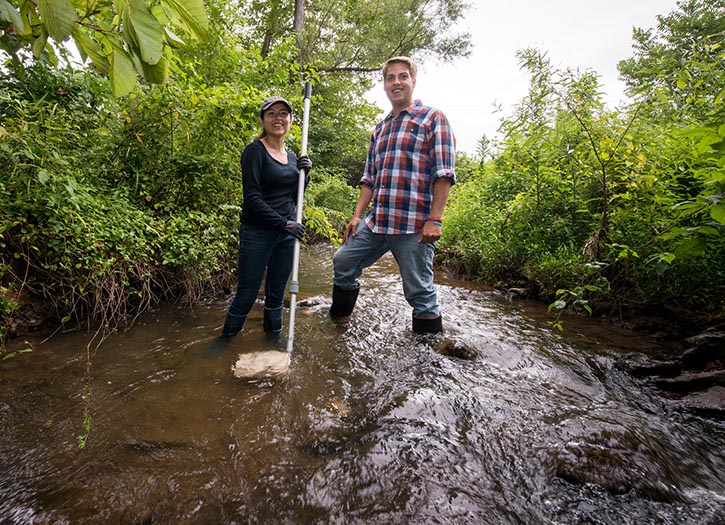
Students from the Sid and Reva Dewberry Department of Civil, Environmental, and Infrastructure Engineering study the flora and fauna of the tributaries of the Shenandoah River during a week-long course at the Smithsonian-Mason Campus near Front Royal, Virginia. Photo by Evan Cantwell.
Last summer students from the Sid and Reva Dewberry Department of Civil, Environmental, and Infrastructure Engineering geared up in waterproof field boots, hats, and bug repellant to participate in a week-long course, Environmental Assessment and Watershed Process.
For decades, the Shenandoah River and its tributaries running through the Front Royal, Virginia community, home to the Smithsonian-Mason School of Conservation, have been plagued with threats to water quality from a nearby Superfund site (i.e. The Avtex Fibers, Inc. site) and significant agricultural operations in the region.
“We wanted to give our students an opportunity to live and study at this beautiful and unique site of the campus near Front Royal,” says Liza Wilson Durant, associate dean of strategic initiatives and community engagement. “We recognize the impact of hands-on experiential learning on the student experience. Field and laboratory experiences are often the most engaging part of a course and the closest to real world application of classroom knowledge."
The course quickly filled and reached capacity. Students traveled to the Shenandoah Valley, and lived in dormitories at the Front Royal campus for one week. They worked around the clock in teams, acting as consultants to address a real-world problem involving data collection (field and lab), modeling and simulation (computer lab) and communication (report out and presentation).
During the day they waded into the streams and tributaries of the Shenandoah, reaching under rocks to find crayfish and other “critters” signaling the health of the stream. They measured nitrogen, phosphate, turbidity and flow with sensors and then returned to the labs in the evening where they used computational methods to develop a model of the watershed that drains the regions surrounding area. Their projects characterized the current state of the watershed as well as threats to the water quality and ecology. Their experience ended with a presentation of the watershed management plan that they developed during the week-long course.
Professor and Associate Dean, Strategic Initiatives and Community Engagement, Volgenau School of Engineering, Liza Wilson Durant, Associate Professor Celso Ferreira, and Assistant Professor Viviana Maggioni collaborated to develop and teach the immersive 3-credit course. The course will be offered again in August 2019.
“We wanted to give our students an opportunity to live and study at this beautiful and unique site of the campus near Front Royal,”
Liza Wilson Durant, Professor and Associate Dean for Strategic Initiatives and Community Engagement
